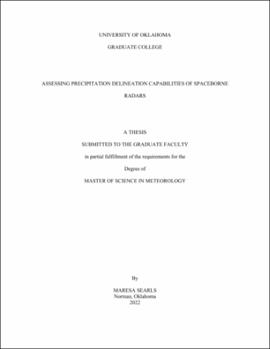| dc.contributor.advisor | Kirstetter, Pierre | |
| dc.contributor.author | Searls, Maresa | |
| dc.date.accessioned | 2022-07-27T17:01:04Z | |
| dc.date.available | 2022-07-27T17:01:04Z | |
| dc.date.issued | 2022-08-04 | |
| dc.identifier.uri | https://hdl.handle.net/11244/335972 | |
| dc.description.abstract | Spaceborne radars uniquely measure, provide the finest depiction of, and give the most accurate estimate of precipitation globally from space. The Global Precipitation Measurement (GPM) mission dual-frequency precipitation radar (DPR) is the successor to the Tropical Rainfall Measuring Mission (TRMM) precipitation radar (PR), expanding on its capabilities with a dual-frequency radar and coverage into the midlatitudes. The consistent ability to detect various precipitation magnitudes across satellite missions is critical to the study of global precipitation over various time periods. The precipitation delineation capabilities of spaceborne radars are characterized as functions of their reflectivity and the corresponding precipitation magnitude from the reference Ground Validation Multi-Radar/Multi-Sensor (GV-MRMS) over CONUS. The Heidke Skill Score, a measure of skill with respect to random chance, is computed to synthesize the capabilities of the spaceborne radars. This enables a finer depiction and interpretation of spaceborne radar capabilities than the bulk metrics widely used in the literature. Skill is more sensitive to changes in rain rate at lower rain rates and changes in reflectivity at higher rain rates. The TRMM-PR and GPM-DPR best delineate moderate precipitation while the GPM-KuPR detects precipitation with low to moderate skill. While both the TRMM-PR and GPM-DPR perform better than GPM-KuPR, the TRMM-PR performs better at lower reflectivity thresholds while the GPM-DPR performs better at higher reflectivity thresholds. Certain factors do not have a significant impact on the overall skill. Others have a significant impact, but the number of cases were small and did not greatly impact the overall skill. While the GPM-DPR struggles with the detection of precipitation, and the TRMM-PR performs the best overall, both the GPM-DPR and TRMM-PR have good delineation capabilities. | en_US |
| dc.language | en_US | en_US |
| dc.subject | precipitation | en_US |
| dc.subject | spaceborne radar | en_US |
| dc.subject | TRMM | en_US |
| dc.subject | GPM | en_US |
| dc.title | Assessing Precipitation Delineation Capabilities of Spaceborne Radars | en_US |
| dc.contributor.committeeMember | Basara, Jeffrey | |
| dc.contributor.committeeMember | McFarquhar, Greg | |
| dc.date.manuscript | 2022-07-20 | |
| dc.thesis.degree | Master of Science in Meteorology | en_US |
| ou.group | College of Atmospheric and Geographic Sciences::School of Meteorology | en_US |
| shareok.orcid | https://orcid.org/0000-0002-5165-224X | en_US |
